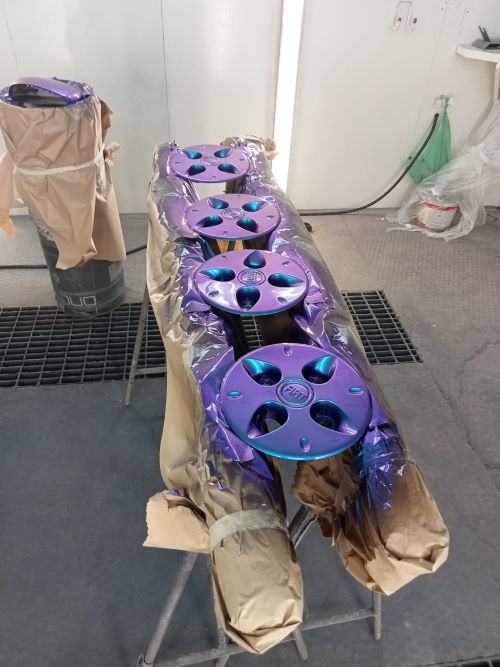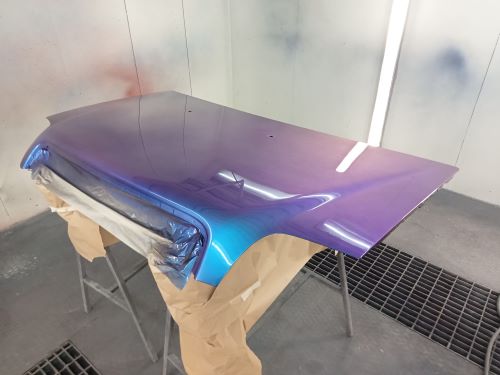 General information on applying lacquer and paint
General information on applying lacquer and paint
This article deals with the subject of applying paint, only in the field of automotive or industrial paints and only applied with a pneumatic gun or airbrush. We will not naturally talk about artistic types of paints or interior and exterior decoration for walls and facades.
The term painting generally encompasses all paintings. More specific terms make it possible to specify the type of paint. Here are some examples: a lacquer, a finish, a base, a varnish, a primer, a primer, a direct gloss paint...
There is a method of application which generally refers to the tool or technique used to apply the product: the pneumatic gun, the Airless gun, the brush, the roller, the airbrush... There is then the paint application technique, which consists of instructions for surface preparation, mixing of products and actual application.
Correct and perfect application of paint with a spray gun does not mean that the project is a sure success. The preparation of the support plays the greatest part in the success and accomplishment of a painting.
On the other hand, we speak of a paint system, because a paint is often part of a set of coats (primer, paint, varnish).
The application of a paint is theoretically the transfer of the liquid product in the pot to the surface or support. By spraying with a gun or airbrush, the enormous advantage is that at no time will the applicator or the tool touch the support.
During transfer from the gun to the surface, some product may be lost, with misting and paint aerosols. This is where the term HVLP and LVLP come from: new guns use less air, less pressure and this reduces the amount of paint wasted.
In the following paragraph, we will therefore see the method of applying paints most often encountered in the bodywork and industry profession.
General techniques for applying paints and lacquers
Here are the different application techniques specific to each paint:
Lacquers: these are the oldest paints, they are thick and shiny. They are found with a wide variety of chemical formulas, in polyurethane, in glycero, in acrylic, in a water-based version or in a solvent-based version. This type of paint is prone to running if too much is applied and the surface to be painted is vertical. On the contrary, when you apply too thin a layer, the lacquer will not be able to produce its main quality which is shine. Indeed, lacquers are thick, resistant and shiny finishing paints in most cases.
> Application in 2 “wet” or glossy coats, with an interval of 5 to 10 minutes. A layer thickness is necessary to promote tension and self-smoothing of the glossy film. This can also be favored with the addition of thinner to lower the viscosity of the paint, but without excess, because the thinner promotes runs and also a loss of shine. Final dry thickness: 40 – 60µm.
“Base varnish” type paints: the use of these one-component paints is not intended to produce resistant finishes. They are always varnished. Their main property is to be very fine, dry quickly and create beautiful colors. Unlike finishing lacquers, these are very fluid paints that should always be applied in multiple thin, successive layers until sufficient thickness and, above all, the optimal color are achieved. The painter should never fully depress the trigger of his paint gun. It must send “more air than paint”. Drying of the paint film is essentially produced by evaporation of the solvent, this is air drying.
> Applying paint using “thin veils” or thin layers is widely recommended.
Final dry thickness: 20-35µm.
 The main faults for the implementation of lacquers and varnishes
The main faults for the implementation of lacquers and varnishes
It is sometimes possible to discover during application or drying, some sort of defect which manifests itself as multiple hole-shaped openings through the glossy lacquer or varnish.
These openings reveal the underlay. This type of defect often occurs when a thick layer is applied to a non-degreased surface or one with a certain “surface tension”. Certain contaminations, such as greases or invisible silicones, prevent the paint from wetting and distributing itself by self-smoothing on the support.
It is practical, in case of doubt, to start an application of lacquer or varnish, by making 1 or 2 ultra-thin coats, called “adhesion coat” or “flash coats”. This helps prevent these types of problems, holes or openings, from occurring.
Of course, the most well-known defect is sagging. There are clearly identified causes for the occurrence of this defect and it comes from the application of the paint and also the mixing. Dripping occurs, mainly on vertical surfaces, when excess product has been applied.Of course, this defect is favored by excessive dilution or too low a temperature.
The main faults for the implementation of two-coat type paints
Bilayer is the official name given to varnish base paints. This term refers to this 2-step painting system, which are the base, then the varnish. These paints being very fluid and very liquid, they can dry quickly and sometimes too quickly, both when mixed in solvent formulas, but also in hydro formulas. Failure to “chark” or “powder” occurs when paint is sprayed at an excessive distance from the substrate (i.e. the paint gun is not positioned at the optimal distance of 15 cm from on the surface). This defect is favored by working in excessively high temperatures and usually occurs in summer. It is estimated that above 25°, it is imperative to use a drying retarder, in the form of a slow diluent. Dusting paints creates a sort of powder or grain stuck to the surface of the paint. This unaesthetic appearance can be easily corrected with very fine wet sanding, then covering with a coat of paint followed by varnish. Drying a paint and baking Covering and varnishing a painting Specificities of the techniques applied to painting
Drying a paint and baking
Covering and varnishing a painting
Specificities of the techniques applied to painting



















































































